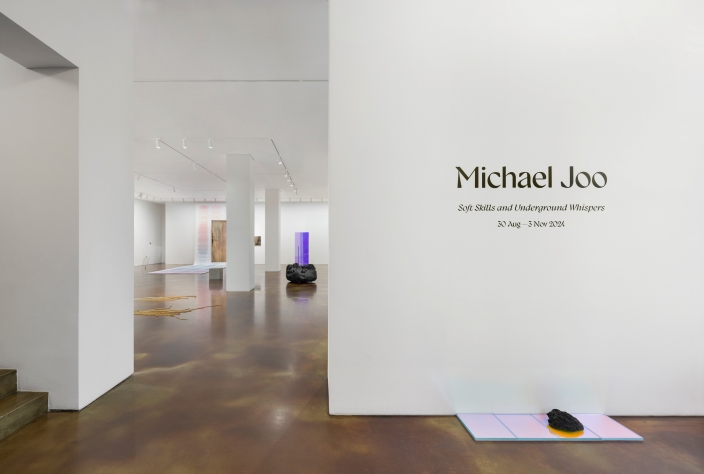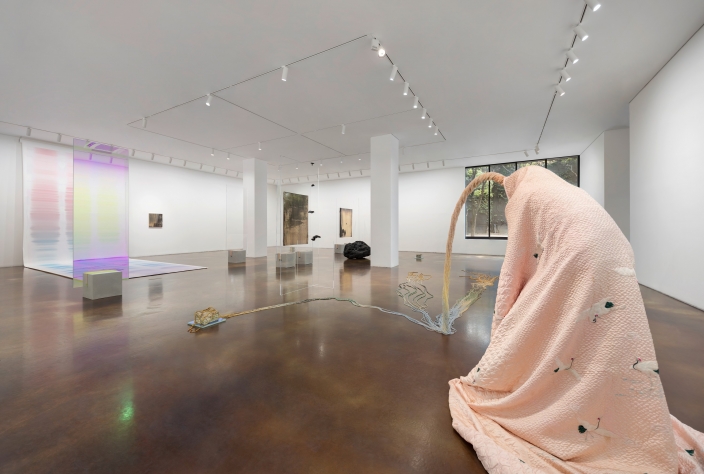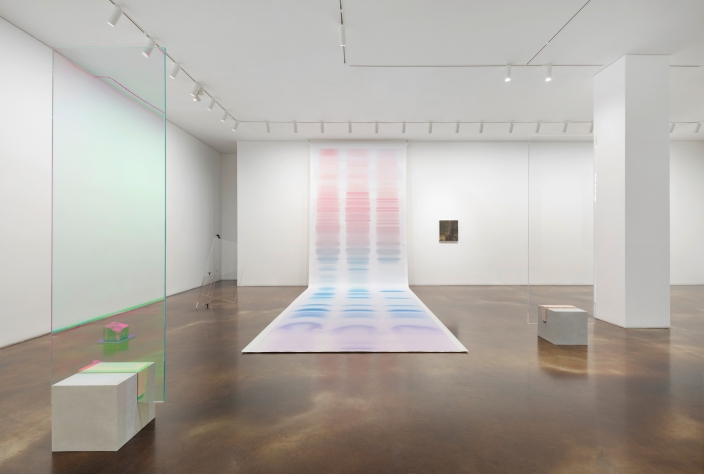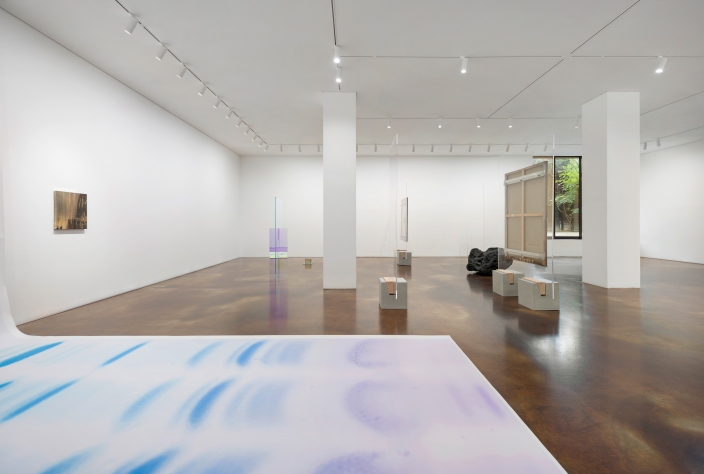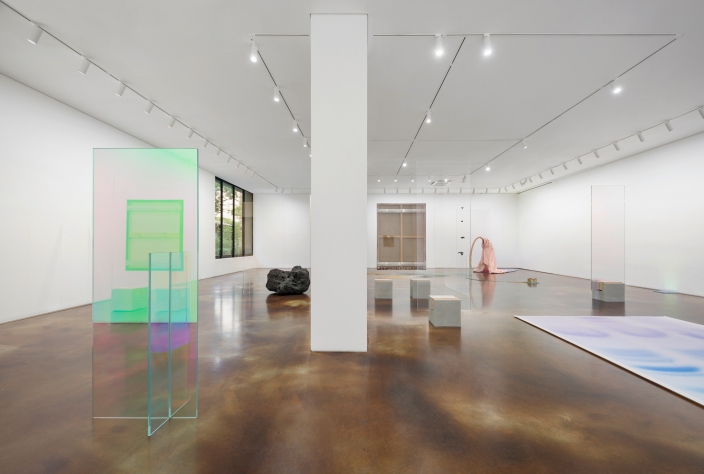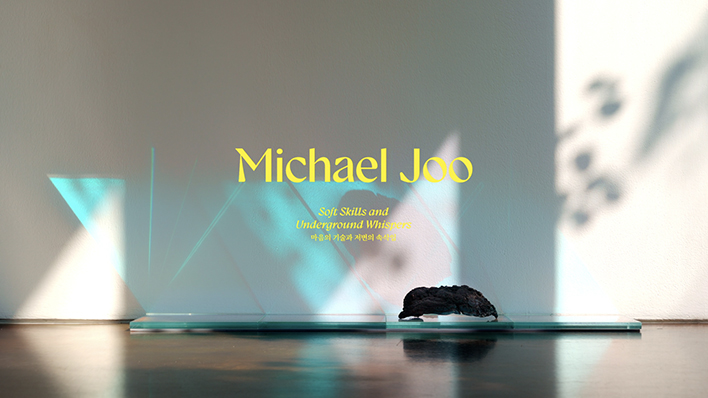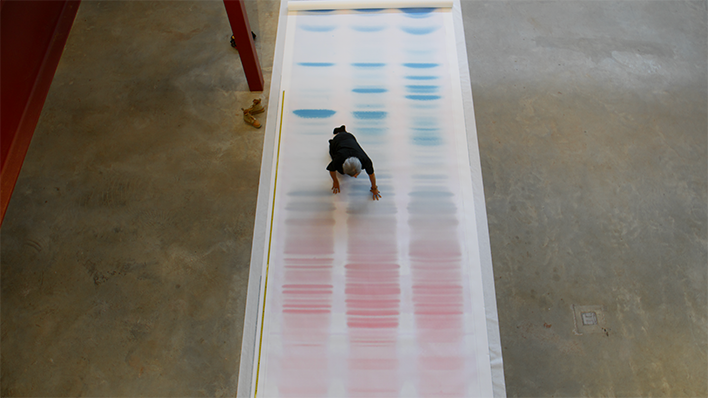Kukje Gallery is pleased to present Michael Joo’s Soft Skills and Underground Whispers, a new installation of recent works on view from August 30 to November 3, 2024. For his second solo exhibition in Seoul with the gallery since 2017, Joo engages gallery K2 with a dense yet delicate visual field of crystalline surfaces, interesting geometric shapes, and materially charged objects. Continuing his ongoing inquiry into perception, identity, and liminality, Joo mines the intersections of art, science, and belief as the exhibition’s methodology emphasizes the exchanges, connections, and ineffable relations of mutual influences that occur at the subliminal level of perception.
A poetic phrase that encapsulates these themes, the exhibition title “Soft Skills and Underground Whispers” hints at this range of hidden networks that operate like whispers vibrating from underneath, and calls viewers’ attention to the soft skills that contour invisible relations and intimacies. Upon entering the gallery, the viewer is first presented with a new group of works from the artist’s Revider series, which embodies Joo’s ongoing use of materials and modalities that both separates and connects space. Constructed from both clear acrylic and dichroic glass—which displays a wide spectrum of colors visible from different viewing angles—the works present transparent and kaleidoscopic surfaces that visually animate the static object. For Joo, the unstable optical quality of the materials encourages the viewer to engage by shifting one’s position and gaze.
Objects delicately mounted on their surfaces appear suspended in space, visible in their relationship to each other. Upon closer inspection the rich black objects in Revider for Ganoderms (Yeongjiboseot 1, 3) (2024) reveal themselves to be carbonized reishi mushrooms made using a process that Joo developed with traditional white charcoal makers—merging new and centuries-old technologies. The material transformation to pure carbon takes the object beyond the point of combustion into a material that is so hyperporous that it can purify air and water at an ionic level, connecting the seemingly inert with the continuously active, while visually and spatially alluding to the invisible subterranean networks that connect fungi with their surrounding ecologies. Central to the grid-like yet lyrical arrangement of panels is Revider with Carbon Doppelganger (2024), a crystalline acrylic construction which, depending on one’s perspective, is either being penetrated by or merged with a large, sculpted boulder. Carved from a composite block of carbon dust, graphite, wood charcoal, and urethane by a seven-axis robotic arm, the stone takes its form directly from volcanic rocks collected by children living in the area bordering the Demilitarized Zone along the Hantan River during Joo’s 2018 REAL DMZ PROJECT. Using scanned details from these site-specific samples, the stone accrues multiple identities: it is a synecdochic part that speaks to the larger context of the DMZ, an artifact born out of technical mediation, a burnt object whose components have been mutated as a result of combustion, and a material that is comprised of the elemental (carbon, graphite), the residual (charcoal), and the artificial (urethane). This destabilizing of the hierarchical relation between an object and its support is another clear example of Joo’s resistance to containment and his commitment to continuously engaging with the entangled narratives found in and perpetuated by material artifacts.
Installed further in the K2 space is Untitled (after LBB) (2024) which pays homage to Joo’s long-standing regard for the “glass easels” designed by the Italian-born Brazilian architect Lina Bo Bardi (1914–1992). Conceived for the opening exhibition of the Museu de Arte de São Paulo (MASP) in 1968, the “glass easel” refers to Bo Bardi’s original display system consisting of a pane of glass wedged into a concrete cube, which together form a self-supporting structure for an artwork attached to the sheet of glass. Eliminating the historical authority and didactic aura traditionally associated with the display method of works hung on the wall, the glass easels invite a more intimate and direct relationship with an artwork that stands in close proximity to each viewer. Joo’s interpretation of this as a portable and provisional architecture that blurs the boundary between the inside and outside, as well as its status as a liminal plane signaling an opening to another kind of space, has been a direct influence on the artist’s strategies of display, ranging from the glass ropes and stanchions of the Expanded Access series (2001–present) to the silvered glass and polycarbonate shield series such as in Plexus (2013) and Indivisible (2010–2012). In two of the works displayed on these supports, Barcelona and The Vagueness Argument (both 2017), metallized, reflective surfaces fluctuate in silver, gold, and copper hues, shifting according to the viewer’s position and movement and further connecting them with the surrounding environment. Part of an ongoing series of silvered epoxy paintings, the works continue Joo’s decades-long research developing an innovative method that merges glass silvering techniques familiar to traditional photography with printmaking processes. The poetic potential and physicality of combining these two mediums allows Joo to create site-specific “prints” of surfaces in remote sites such as abandoned structures, borderlands, and contested territories, an environmental record “fixed” over long duration in the cured epoxy that can then be retrieved and silvered. In doing so, the artist has invented what he describes as an “image making process to amplify presence and merge subject with context,” marrying the subtlety of the silver and the concrete relief of the cured epoxy, to reveal and highlight the resulting textures and forms of his locations.
Placed at intentional intervals throughout the installation, the series of works Cosms (Catalunya 1, 2, 5, 7) (2016– 2024) also explores site by investigating the discipline of archaeology, framing subjects including subterranean geology, identity, place, and migration. The works highlight the artist’s interest in the science of excavation and how the different forensic categories of biofact, ecofact, and geofact establish the rubric of authority that surrounds history, an interest that underpins the entire exhibition. Resembling broken architectural columns, Cosms (Catalunya 1, 2, 5, 7) consist of compact blocks of alabaster stone, carefully cut to reflect their relationship to the landscapes beneath which they are typically buried. Silvered and placed on dichroic glass plates, the carved works amplify their physical origin, encouraging the viewer to connect to a sense of deep time and physical scale.
The complex mycorrhizal logic suggested by the title “Underground Whispers” extends to a more deeply personal realm in the final two works that anchor the exhibition. In EP Cascade (2024), what appears to be a sumptuous streak of watercolor at first glance, is in fact an AI modified image derived from a process of DNA molecular separation using electrophoresis, separating molecules by mass to assist in determining genetic identities. The color palette of the work was based on that of the dichroic glass spectrum and applied to the image profile, creating a visual resonance with the sculptures. As a work that visualizes genetic information and is therefore a blueprint of a life, EP Cascade is also a tender tribute to the influence of the artist’s mother, who was a plant physiologist and electrophoresis specialist, evoking the idyllic waterfalls he and his siblings experienced as children in upstate New York. Finally, the lone figurative form suggested in Mediator (redux) (2024) incorporates a family heirloom brought over to the US from Korea in the 1980s. Echoing the sculptural form that appeared in Caroline Tisdall’s documentation of Joseph Beuys’ iconic 1974 performance, I Like America and America Likes Me, a critique of European and American relations as well as an exploration of the conflicting mystique and reality of American identity, the subtle sheen of the pink sateen quilt in Joo’s work appears to fall and drape naturally over an absent human body. The artist takes this evocation of generational personal history further by incorporating a dense strand of stone beads that seem to come from within the figurative shroud. Like pollinating corn silk, the networked spray of lines emanating from the work weaves the interstices of other works into fertile connections, as if facilitating the cross-pollinations and transmissions of the softest of whispers.
About the Artist
Born in Ithaca, New York, in 1966, Michael Joo is based in Brooklyn, New York, regularly living and working between the Americas and Asia. A John Simon Guggenheim Memorial Foundation Fellow since 1998, Joo received an MFA from the Yale University School of Art in 1991. Joo is both a Senior Critic in Sculpture at Yale University and a Mentor in the Columbia University MFA program. 2024 has been a busy year for the artist, who in addition to currently showing at Palazzo Malta, Venice, Italy, is preparing for upcoming group exhibitions at the Hammer Museum, Los Angeles opening in September; Silverlens, New York in October; and Whitney Museum of American Art in November. Joo has held solo exhibitions at numerous institutions and galleries including Art Sonje Center, Seoul (2018); Kukje Gallery, Seoul (2017); Savannah College of Art and Design, Georgia (2016); Freer | Sackler, part of the Smithsonian Institution, Washington, D.C. (2016); The Bronx Museum of the Arts, New York (2014); The Aldrich Contemporary Art Museum, Connecticut (2014); Rodin Gallery, Seoul (2006); Palm Beach Institute of Contemporary Art, Florida (2004), and MIT List Visual Arts Center, Cambridge, Massachusetts (2003). He has participated in past group exhibitions at institutions across the globe, including the Philadelphia Museum of Art (2023); Denver Art Museum, Colorado (2022); Brooklyn Museum, New York (2021); National Museum of Modern and Contemporary Art, Gwacheon (2016); Whitney Museum of American Art, New York (2015, 2000); Sharjah Biennial (2015); and Gwangju Biennale (2012, 2006, 1995), among other venues. In 2001, Michael Joo was selected to represent the Korean Pavilion at the 49th Venice Biennale, together with Do Ho Suh. Among Joo’s numerous awards are a Smithsonian Artist Research Fellowship (2012), Grand Prize at the 6th Gwangju Biennale (2006), United States Artists Fellowship (2006), Andy Warhol Foundation Grant (2001), Joan Mitchell Foundation Painters’ and Sculptors’ Grant (2000). His works are in the permanent collections of the Museum of Modern Art (MoMA), Guggenheim Museum, Whitney Museum of American Art, and Brooklyn Museum in New York; Walker Art Center, Minneapolis; Moderna Museet, Stockholm; and M+ Museum, Hong Kong, among others.


